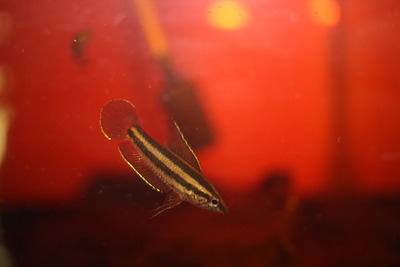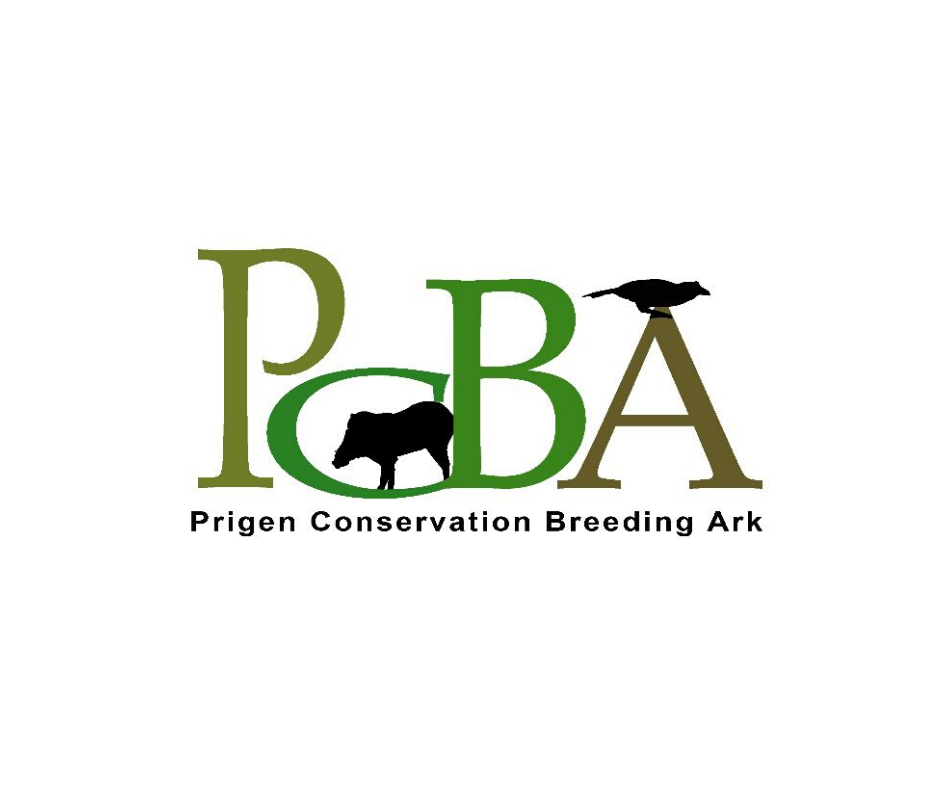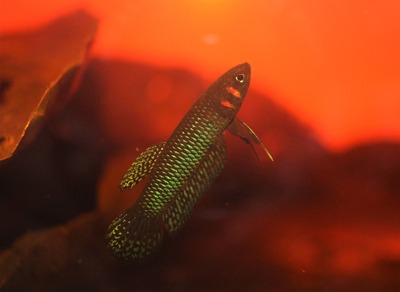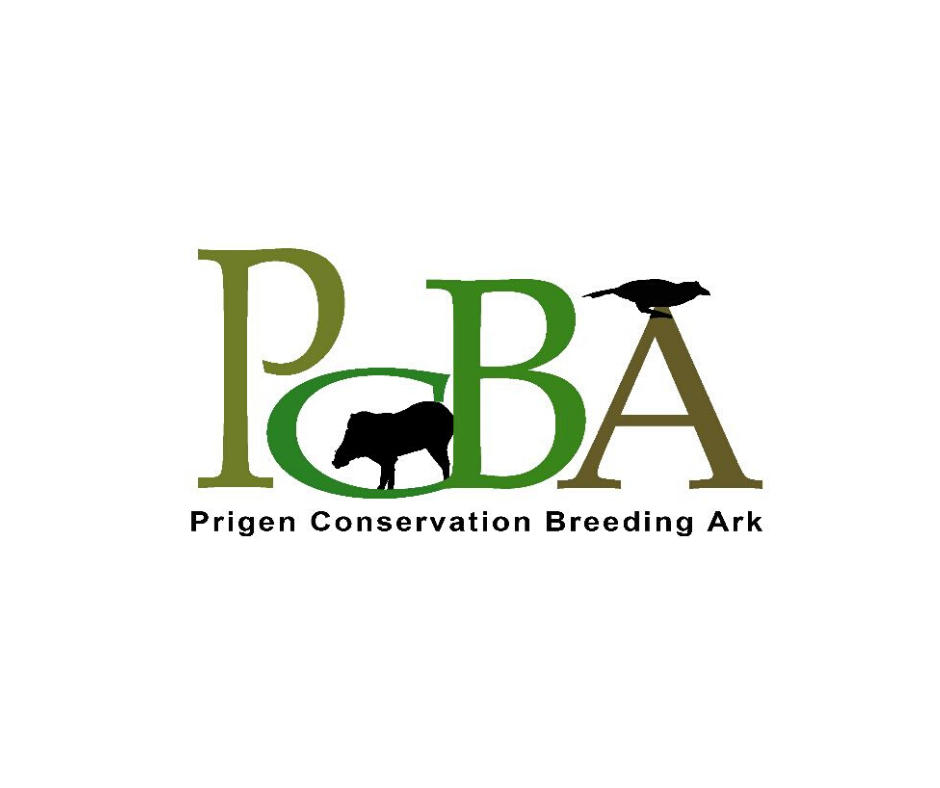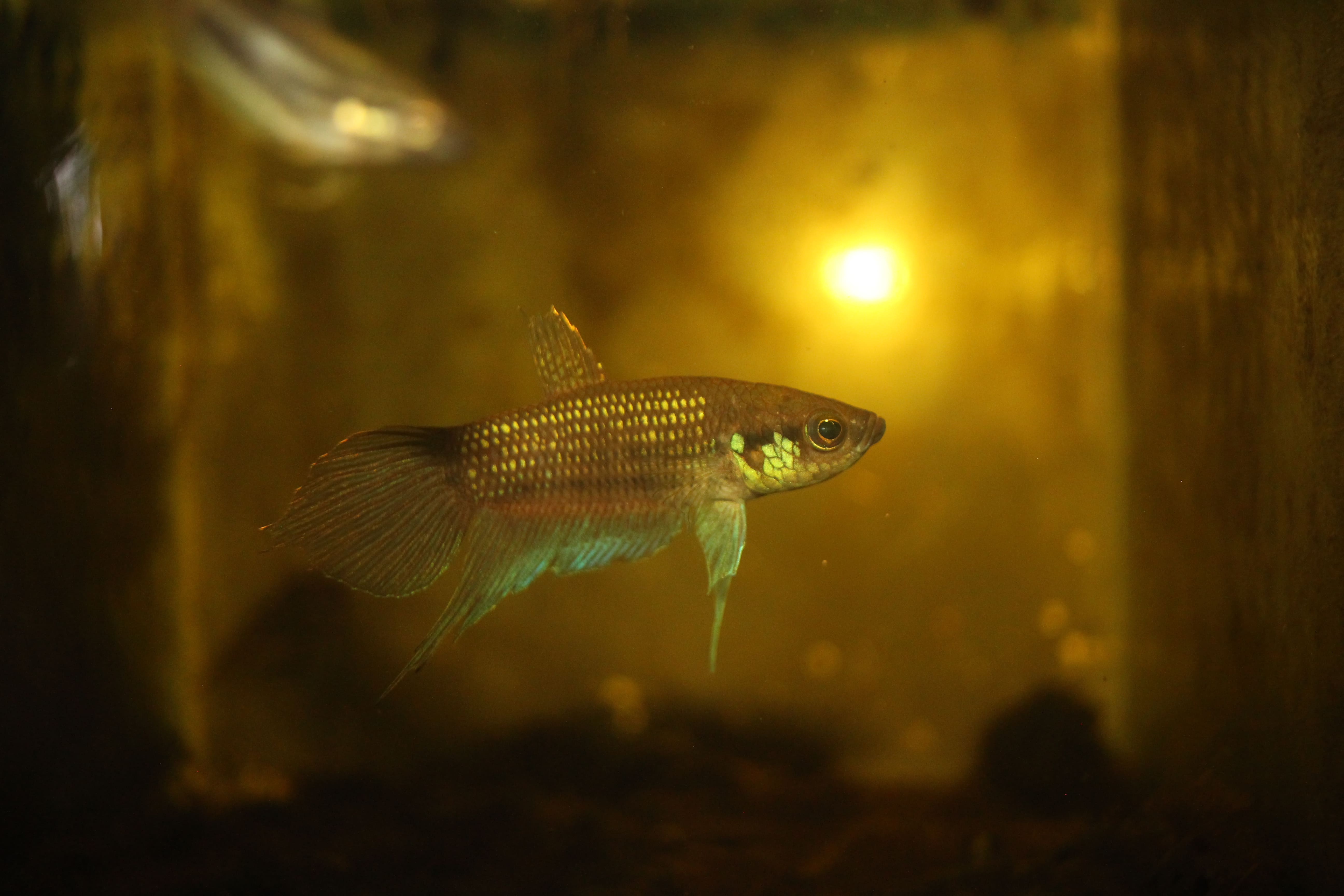Parosphromenus pahuensis
Parosphromenus pahuensis
IUCN: EN (Endangered)
Found in Kalimantan. Distinction between sexes of this species can be difficult as the colour patterns on the fins are similar for both male and female. However, the males fin colouration is a bit more distinct and colourful than the females, and the dorsal fin is slightly more pointed, which is recognisable from sub-adult age. Threatened due to agriculture and land development.
Parosphromenus linkei
Parosphromenus linkei
IUCN: EN (Endangered)
An Indonesian endemic found in the lowlands of central Kalimantan. The male of this species is generally bigger than the female and has a longer dorsal fin. Despite a wide natural distribution, the species is under a high level of threat due to draining of their native habitat for agricultural purposes and removal of natural vegetation.
Parosphromenus bintan
Parosphromenus bintan
IUCN: VU (Vulnerable)
This species is endemic to Bintan Island. When the male is in breeding condition, his fins will have a blue band and the edges have a thin white like with darker colours between. The female appears similar to other species, creating a risk of hybridisation in captivity if the aquarist is not careful.
Parosphromenus phoenicurus Indragiri
Parosphromenus phoenicurus Indragiri
IUCN: CR (Critically Endangered)
It’s IUCN rating is owed to its incredibly limited range in a single blackwater swamp in Sumatra. Wild specimens measure around 3cm. The most striking difference to other similar species is the caudal fin which deviates slightly. It is considered one of the most attractive of the liquorice gouramis.
Parosphromenus deissneri
Parosphromenus deissneri
IUCN: EN (Endangered)
Found only on Bangka and Belitung, this is one of the largest liquorice gouramis measuring up to 5cm in length. In breeding condition, the male is easily identified compared to other species by his one centimetre long, triangular, black caudal filament. They have a very limited range, making their threat of extinction more likely.
Parosphromenus juelinae
Parosphromenus juelinae
IUCN: NE (Not Evaluated)
Restricted to peat swamp forest in a small area of Bangka Island. It is threatened by human activities such as settlement, mining, and plantations. Whilst currently not evaluated by the IUCN, it is recommended to be listed as Critically Endangered as the three locations it is known are under severe threat.
Parosphromenus anjunganensis
Parosphromenus anjunganensis
IUCN: EN (Endangered)
Restricted to the catchment area of the Kapuas river system. Faces threats due to drainage of its habitat for human settlement and agriculture.
Parosphromenus opallios
Parosphromenus opallios
IUCN: EN (Endangered)
Present in central Kalimantan, this Indonesian endemic is mostly found in overgrown shallow areas. Different localities of this fish species can have slightly different colourations. Faces threats due to lowland rainforest destruction for human development.
Parosphromenus filamentosus
Parosphromenus filamentosus
IUCN: EN (Endangered)
Occurs in central Kalimantan however the true extent of its range is unknown. Despite this, the threat level it faces is high due to the level of deforestation in its current known range.The caudal fin is characteristic to the species, being extended with an inner area of red/brown into black into a thin white/blue tipped edge. This makes this species visually quite distinct compared to other species of liquorice gourami.
Parosphromenus quindecim
Parosphromenus quindecim
IUCN: CR (Critically Endangered)
From southeast Kalimantan, the wetlands it relies on are undergoing heavy drainage and change of use making this species highly threatened. Visually this fish is quite distinct, with a body length up to 5cm. The male features multicoloured banded fins. Dominant females can be as colourful as the male.
Betta coccina Indragiri
Betta coccina Indragiri
IUCN: VU (Vulnerable)
Its common name is scarlet betta and its scientific name of ‘Coccina’ meaning red, points towards the vibrant red colours of this fish species. Males are brighter than females and develop longer fins. The species is native to Sumatra.
Betta hendra
Betta hendra
IUCN: CR (Critically Endangered)
From central Kalimantan found in peat swamp forest, sharing the same habitat as the world's largest orang-utan population. They are under a high level of threat as the peat swamps they rely on are drained for human use.
Betta rutilans
Betta rutilans
IUCN: CR (Critically Endangered)
The scientific name of this species means ‘being red’. They have been observed in west Kalimantan in overgrown peat swamp forest and the associated blackwater streams surrounding. At drier times of the year, the fish may be forced to survive in moist leaf litter for several weeks as permanent water sources become unavailable. This species faces threat from habitat destruction.
Betta miniopinna
Betta miniopinna
IUCN: CR (Critically Endangered)
Endemic to Bintan Island in Riau Province, it is only known from a very small number of localities. They can measure up to 3.5cm long. Typical for these types of fish, they can survive up to several weeks in moist leaf litter during periods of no rain. They face heavy threats of habitat destruction as their home island is developed for tourism resulting in peat swamps being drained and forests cut down to make way for hotels and golf courses.
Betta persephone Indragiri
Betta persephone Indragiri
IUCN: EN (Endangered)
This species is known from Peninsular Malaysia and Sumatra. Visually quite stunning, it is a deep black with vibrant blue fins. Like other peat swamp inhabitants, it faces threats from swamp draining and changes in land use for human activities.
Betta burdigala
Betta burdigala
IUCN: CR (Critically Endangered)
Only found on Bangka Island, this species tends to measure 3-3.5cm in length. Like other betta fish, they inhabit peat swamp forests.
Betta uberis Nanga Tayap
Betta uberis Nanga Tayap
IUCN: VU (Vulnerable)
This species is found in Kalimantan with our specimen coming from Nanga Tayap. Like other Betta species, they feed on small aquatic invertebrates.
Betta cf. uberis Belitung
Betta cf. uberis Belitung
IUCN: VU (Vulnerable)
While B.uberis sensu stricto is a Bornean native, our fish from Belitung Island appear similar but not the same as true B.uberis and might represent a new species.
Betta dimidiata
Betta dimidiata
IUCN: VU (Vulnerable)
From western Kalimantan, this fish can reach up to 4.6cm in length. They inhabit peat swamp forests and streams, and have been found in pools measure just a few cm deep. Males are larger than the females with iridescent scales on their head which is also generally broader in shape than the females'.
Betta taeniata
Betta taeniata
IUCN: DD (Data Deficient)
This is a paternal mouthbrooder species meaning the males look after the eggs and take care of offspring in their mouths for a period of time. Males are larger and show iridescence on their heads. This species is found in west Kalimantan. This species is more associated with clear flowing hill streams with some leaf litter and gravel.
Betta foerschi
Betta foerschi
IUCN: EN (Endangered)
Found in just a small number of locations in central Kalimantan, inhabiting forest swamps and streams sometimes just a few cm deep. Males are more colourful than females and develop unpaired extended fins.
Betta mandor
Betta mandor
IUCN: EN (Endangered)
Threatened by illegal logging activity in the peat swamp forests it is found, this species hails from west Kalimantan in well-shaded swamp pools and streams. They can grow up to 6cm in length, and like other species within this genus, the males are more colourful than the females with longer fins.
Betta spilotogena
Betta spilotogena
IUCN: EN (Endangered)
Found in north Bintan and Singkep Island in the Province of Riau Islands, they inhabit freshwater swamps and associated streams. Males and females are more similar in appearance than other species, though males are still slightly more colourful and have a broader head. They are generally 6-7cm in length. Threatened with change in land use as areas are developed for plantation, human settlements or the tourism industry.
Betta hipposideros Indragiri
Betta hipposideros Indragiri
IUCN: EN (Endangered)
The type kept at PCBA is found around the Indragiri River, however it is found in Peninsular Malaysia and other areas of Sumatra. A paternal mouthbrooder, meaning the male takes care of the eggs in his mouth. In the wild this species has been found in very slow moving and stagnant pools of water full of leaf litter.
Betta enisae
Betta enisae
IUCN: DD (Data Deficient)
Only known from parts of the Kapuas river basin in western Kalimantan, it has not been extensively surveyed in the wild hence its designation of Data Deficient by the IUCN. Despite this, they are likely highly threatened like other species in the area due to logging and development. Like other species in the genus, pools they are found in are heavily shaded from the sun, keeping them cool.
Betta pinguis
Betta pinguis
IUCN: CR (Critically Endangered)
The scientific name of this species, ‘Pinguis’, means stout, which refers to their large body size of up to 8cm long. Only known from the middle and upper Kapuas water basin. The males have more iridescence than the females and a broader head.
Betta antoni
Betta antoni
IUCN: EN (Endangered)
Endemic to the lower Kapuas river basin, they are found in clear flowing forest hill streams with a mixture of gravel and leaf litter. Males grow larger than the females and have a greater number of iridescent scales on their broader head.
Betta aff. anabatoides Bangka
Betta aff. anabatoides Bangka
IUCN: LC (Least Concern) asseses as B.anabatoides
Whilst B.anabatoides is a Bornean species, the fish kept at PCBA are found on Bangka Island which is to the east of Sumatra and might very well represent a new, potentially threatened species.
Betta chloropharynx
Betta chloropharynx
IUCN: CR (Critically Endangered)
A Bangka Island endemic, this large species can reach up to 8.5cm in length. They inhabit peat swamp and other blackwater areas. They prey on small aquatic invertebrates. Like other species, the male is more colourful with a broader head and are more colourful than the females.
Betta schalleri
Betta schalleri
IUCN: EN (Endangered)
Sometimes known as Schallers mouthbrooder, this species is found on Bangka Island where it inhabits hill streams and peat swamps.
Sphaerichthys vaillanti
Sphaerichthys vaillanti
IUCN: EN (Endangered)
Endemic to the Kapuas River basin, they mostly inhabit blackwater areas though have also been found in clear water. Males and females can be difficult to tell apart when stressed, however females are generally the more colourful with a red and green pattern which becomes more intense during courtship, whilst the males maintain their brown colouration. They are a paternal mouthbrooder species and the males will keep the eggs and fry in his mouth for 7-20 days.
Sundadanio gargula
Sundadanio gargula
IUCN: VU (Vulnerable)
Endemic to Bangka Island where it lives in coastal peat swamps. They face threats from the growing tourism industry where its habitat is redeveloped for hotels and golf courses. They are a smaller species reaching no more than 2cm in length.







